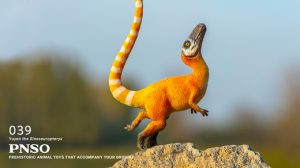Melanosomes Provide Further Proof of Feathered Dinosaurs
Sinosauropteryx – a Ginger Dinosaur
A team of scientists from China and the United Kingdom have published a paper indicating that some small theropod, feathered dinosaurs were red heads, in fact, sort of ginger coloured all over.
The article published in the scientific journal “Nature” highlights the work done on the fine bristle-like structures found surrounding parts of the fossilised skeleton of a turkey-sized, 125 million-year-old dinosaur called Sinosauropteryx. Scanning electron microscopes have shown melanosomes to be present, indicating that these strange features were not the remains of collagen or connective tissue, but most probably feathers.
This is further evidence that many dinosaurs were covered in downy feathers, perhaps to keep them warm but also for display. The melanosomes contain the pigment melanin and from the ratio of different shaped melanosome structures found in the fossilised feathers the scientists have concluded that this particular Sinosauropteryx was ginger coloured.
Feathered Dinosaurs
The scientists have also discovered that this diminutive carnivore had a “Mohican” of feathers running along its head and back and a striped tail.
A View of a Model of Sinosauropteryx

PNSO Yuyan the Sinosauropteryx dinosaur model. The colouration of this dinosaur model has been inspired by the scientific paper.
Sinosauropteryx
Sinosauropteryx caused a sensation when its discovery was announced in 1996. The fossil of this one- metre-long dinosaur, was found in the Cretaceous deposits of the Liaoning Province in China. The fossil showed a perfectly preserved small, theropod dinosaur with a covering of an enigmatic fuzz (“protofeathers”), some of these feathery filaments were up to 4 cm long.
To view the range of prehistoric animal figures in the PNSO series: PNSO Age of Dinosaurs Models and Replicas.
The joint Chinese and British team first scanned the fossils of a Cretaceous bird – Confuciusornis. Confuciusornis is a primitive bird that bridges the morphological and anatomical gap between creatures like Archaeopteryx and modern birds. It is the most common bird fossil find in the Jehol deposits of Liaoning.
Using an electron microscope to look inside the feathers, researchers were able to see microscopic structures called melanosomes, which, in life, contain the pigment melanin.
Professor Mike Benton, of the University of Bristol, (UK), the leader of this research project commented:
“Melanin is what gives colour to human hair and animal fur. They are also the most common way that colours are [produced] in feathers.”
Professor Benton explained that differently shaped melanosomes produced different colours, with blacks or greys produced by “sausage-shaped” melanosomes, and reddish or “russet” shades found in spherical ones.
“A ginger-haired person would have more spherical melanosomes, and a black-haired or grey-haired person would have more of the sausage-shaped structures,” said Professor Benton.
Having found both types of melanosomes in the fossils of the bird Confuciusornis, the team decided to turn their attention to Sinosauropteryx in a bid to understand more about he nature and structure of its own feathered coat.
The close view of pictures of the head, show the line of feathers running down the head and the neck, described by the scientific team as a “Mohican”.
The electron microscope study focused on the bands of dark and light that could be seen along the tail of the fossil Sinosauropteryx. This close examination has shown that the dinosaur’s “Mohican” was russet or ginger-coloured, and that these bands were in fact ginger and white stripes.
“This is the first time anyone has ever had evidence of original colour of feathers in dinosaurs,” said Professor Benton.
Professor went on to add, that this study confirmed that the bristles on this “rather primitive flesh-eating dinosaur… really were feathers”.
This gives more weight to a very well-supported theory that modern birds evolved from theropods, the group of small carnivorous dinosaurs to which Sinosauropteryx belonged.
“Critics have said that these visible spiny structures could be shredded connective tissue,” Professor Benton explained. “But the discovery of melanosomes within the bristles finally proves that some early dinosaurs were indeed feathered.”
The findings also help to resolve a long-standing debate about the evolution and original function of feathers.
“We now know that feathers did not originate as flight structures,” said Professor Benton.
It seems feather-like structures evolved for insulation and display.
Dr Richard Butler, a palaeontologist at the Bavarian State Collection for Palaeontology, in Munich, Germany, said this was a “fascinating and exciting discovery with important implications for understanding dinosaur evolution and biology. This discovery suggests that with more work we may be able to accurately reconstruct colour patterns in some dinosaur species, and begin to understand how those colour patterns may have functioned for camouflage or display.”

